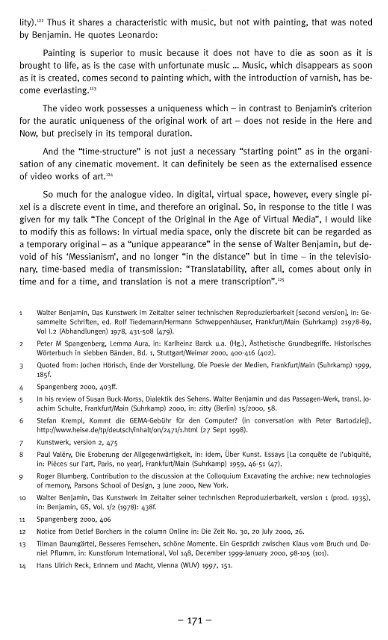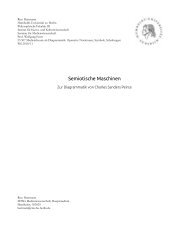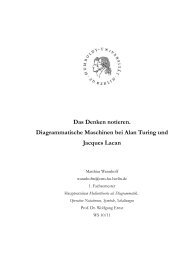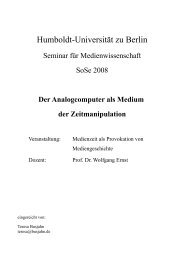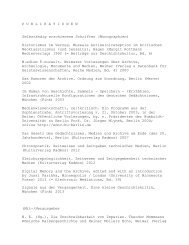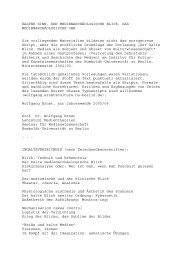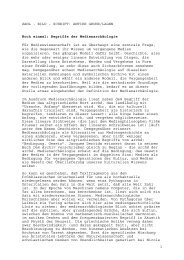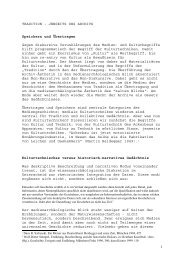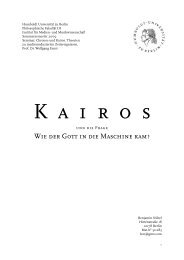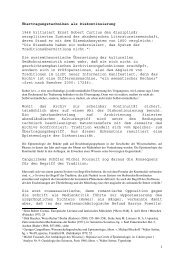Download - Medienwissenschaft
Download - Medienwissenschaft
Download - Medienwissenschaft
Create successful ePaper yourself
Turn your PDF publications into a flip-book with our unique Google optimized e-Paper software.
lity). 122 Thus it shares a characteristic with music, but not with painting, that was noted<br />
by Benjamin. He quotes Leonardo:<br />
Painting is superior to music because it does not have to die as soon as it is<br />
brought to life, as is the case with unfortunate music ... Music, which disappears as soon<br />
as it is created, comes second to painting which, with the introduction of varnish, has become<br />
everlasting. 123<br />
The video work possesses a uniqueness which - in contrast to Benjamin's criterion<br />
for the auratic uniqueness of the original work of art - does not reside in the Here and<br />
Now, but precisely in its temporal duration.<br />
And the "time-structure" is not just a necessary "starting point" as in the organisation<br />
of any cinematic movement. It can definitely be seen as the externalised essence<br />
of video works of art. 124<br />
So much for the analogue video, in digital, virtual space, however, every single pixel<br />
is a discrete event in time, and therefore an original. So, in response to the title I was<br />
given for my talk "The Concept of the Original in the Age of Virtual Media", I would like<br />
to modify this as follows: In virtual media space, only the discrete bit can be regarded as<br />
a temporary original - as a "unique appearance" in the sense of Walter Benjamin, but devoid<br />
of his 'Messianism', and no longer "in the distance" but in time - in the televisional,<br />
time-based media of transmission: "Translatability, after all, comes about only in<br />
time and for a time, and translation is not a mere transcription". 125<br />
ι<br />
Walter Benjamin, Das Kunstwerk im Zeitalter seiner technischen Reproduzierbarkeit [second version], in: Gesammelte<br />
Schriften, ed. Rolf Tiedemann/Hermann Schweppenhäuser, Frankfurt/Main (Suhrkamp) 21978-89,<br />
Vol 1.2 (Abhandlungen) 1978, 431-508 (479).<br />
2 Peter Μ Spangenberg, Lemma Aura, in: Karlheinz Barck u.a. (Hg.), Ästhetische Grundbegriffe. Historisches<br />
Wörterbuch in siebben Bänden, Bd. 1, Stuttgart/Weimar 2000, 400-416 (402).<br />
3 Quoted from: Jochen Hörisch, Ende der Vorstellung. Die Poesie der Medien, Frankfurt/Main (Suhrkamp) 1999,<br />
i85f.<br />
4 Spangenberg 2000, 403ff.<br />
5 In his review of Susan Buck-Morss, Dialektik des Sehens. Walter Benjamin und das Passagen-Werk, transl. Joachim<br />
Schulte, Frankfurt/Main (Suhrkamp) 2000, in: zitty (Berlin) 15/2000, 58.<br />
6 Stefan Krempl, Kommt die GEMA-Gebühr für den Computer? (in conversation with Peter Bartodziej),<br />
http://www.heise.de/tp/deutsch/inhalt/on/247i/i.html (27 Sept 1998).<br />
7 Kunstwerk, version 2, 475<br />
8 Paul Valery, Die Eroberung der Allgegenwärtigkeit, in: idem, Über Kunst. Essays [La conquete de l'ubiquite,<br />
in: Pieces sur l'art, Paris, no year], Frankfurt/Main (Suhrkamp) 1959, 46-51 (47).<br />
9 Roger Blumberg, Contribution to the discussion at the Colloquium Excavating the archive: new technologies<br />
of memory, Parsons School of Design, 3 June 2000, New York.<br />
10 Walter Benjamin, Das Kunstwerk im Zeitalter seiner technischen Reproduzierbarkeit, version 1 (prod. 1935),<br />
in: Benjamin, GS, Vol. 1/2 (1978): 438t.<br />
11 Spangenberg 2000, 406<br />
12 Notice from Detlef Borchers in the column Online in: Die Zeit No. 30, 20 July 2000, 26.<br />
13 Tilman Baumgärtel, Besseres Fernsehen, schöne Momente. Ein Gespräch zwischen Klaus vom Bruch und Daniel<br />
Pflumm, in: Kunstforum International, Vol 148, December 1999-January 2000, 98-105 (101).<br />
14 Hans Ulrich Reck, Erinnern und Macht, Vienna (WUV) 1997, 151.<br />
- I7I -


